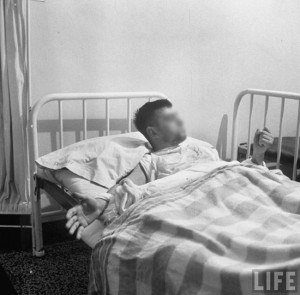In a general sense, patients at asylums were always an experiment in progress. Most alienists didn’t understand why people became insane, and didn’t really know how to cure insanity. Moral therapy, a relatively benign treatment, relied on the idea that a disciplined, busy schedule with plenty of sympathetic conversation, would take patients’ minds off their troubles and help them synch back up with society. Except for the situation itself (being in an insane asylum), this therapy was a fairly gentle attempt to help patients. Many, who perhaps only needed a change of scenery or some diversion to break a melancholy train of thought, probably did benefit from this therapy.
Some twentieth century therapies were more extreme. The last stages of syphilis produced symptoms of insanity, and the condition was usually called “syphilitic insanity.” Doctors infected patients with malaria, hoping the high fever would stop syphilis’s progress. Julius Wagner-Jauregg won a Nobel prize for this therapy. Another leading psychiatrist gave schizophrenic patients high doses of barbiturates to induce deep sleep as a treatment. Another treatment for schizophrenia was insulin shock, in which doctors injected patients with large doses of insulin to produce comas. This therapy was used until the 1950s.
______________________________________________________________________________________









Thank you for your continued interest. As I stated earlier, I didn’t say that insulin shock was not replaced by something else extreme–I’m simply saying that insulin shock was discontinued in the 1950s. And, as I state on my website, I use the language of the times throughout all the history I’m trying to cover. Insulin shock was called treatment during the time it was used, so that is the term I use for it.
Please don’t think that I’m excusing or approving of any of the history I’m presenting. I’m not calling torture a treatment…I’m saying that insulin shock was a sanctioned treatment for insanity, and that’s simply a fact. And, I said insulin shock ended in the 1950s, which is also true. I’m not taking a stand that something similarly horrible didn’t replace it. Many early alienists were sincerely hopeful that they could help restore insane patients to sanity; others were drunk on power and so arrogant that they could not believe that anything they did was wrong. Some very strange treatments developed as theories about mental illness developed; I’m trying to report on what actually happened–there is no approval implied..
Alienists simply did not understand the difference between physical and mental manifestations. Third stage syphilis, pellagra (a vitamin B deficiency), and epilepsy, in particular, presented symptoms that looked like insanity. Therefore, early medical practitioners understood these conditions to be insanity and treated them as such. Again, I’m not agreeing with their diagnoses, I’m just reporting what they were.
I’m so glad that you’re interested in this topic. I really feel that the whole subject of insane asylums has caught the attention of people, lately.
I love how you mix the real as in physical disease (syphilis), with the metaphorical disease of mental illness. How you call torture a treatment. As you have stated the prisoner-patient can not escape or refuse the torture-treatment. You are incorrect about the ending of torture. The torture did not end in the 1950’s. E.C.T. took over after insulin shock became too obvious an act of torture (giving-forcing a poison into the prisoner-patient). Electricity in E.C.T. is an invisible unmeasurable gift to the prisoner-patient.